Mammography

What is a Mammogram?
A mammogram is an X-ray picture of the breast, used as a screening tool to help to detect or diagnose breast cancer.
Why is Mammography important?
Mammograms are used by doctors to look for early signs of breast cancer and are currently the most reliable screening tool. Regular mammograms are the best method doctors use to detect tiny lumps of cancer in the breast, sometimes up to three years before it can be felt by hand by the patient or doctor.
What is Breast Cancer?
Breast cancer is a disease in which cells in the breast experience an abnormal growth and can sometimes be felt as a lump or mass called a tumour. Tumours can be benign (non-cancerous) or malignant (cancerous). In the event that a tumour is cancerous, the cancerous cells can spread to other parts of the body.

Importance of Early Detection
Breast Cancer is the most common cancer among women in Singapore, with 1 in 20 women at risk of developing breast cancer in their lifetime. However, early detection and treatment of breast cancer can significantly improve outcomes and chances of survival. When cancer is diagnosed early, it can be easier to treat and there are more treatment options available. Learn more about health screenings for women here.
More than 90% of women diagnosed with breast cancer at the earliest stage remain well and disease-free after 5 years or more, compared to around 15% for women diagnosed at the most advanced stage.
Who should go for a Mammogram?
Screening mammography is recommended for women aged 40 and above. The Health Promotion Board recommends that women aged 40-49 years have yearly mammograms, and women above 50 years of age, should have a mammogram once every two years.
Women at higher risk of developing breast cancer, such as those with a family history of cancer or breast cancer, should seek advice from their doctors on how early and often they should have screenings.
Regular mammograms lead to early detection of breast cancer and can lower the risk of dying from breast cancer.
What happens during a Mammogram?
The mammography procedure will be conducted by a female radiographer, who will position the breast in the mammography unit on a clear plate. The breast will then be compressed by another plate, flattening, and holding it firmly in place while the x-ray is being taken.
The compression of the breast is necessary to get the best possible x-ray image. Compression holds the breast still to eliminate blurring and reduces the thickness of the breast to allow all tissue to be visible. for the Different women may find the compression uncomfortable or even painful. It is recommended to schedule a mammogram for a time








